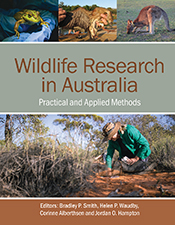Foreword
pp. iii
PDF (619 KB)
Foreword
pp. iii
PDF (619 KB)Table of Contents
pp. v-xiv
PDF (714 KB)Preface
pp. xv-xvi
PDF (647 KB)About the Editors
pp. xvii
PDF (617 KB)List of Contributors
pp. xviii-xxvii
PDF (760 KB)Section 1 Introduction
pp. 2-3
PDF (628 KB)1 Legislation and key concepts
pp. 4-18
2 Animal ethics committees
pp. 19-28
3 Emerging and evolving dilemmas in wildlife research
pp. 29-38
Section 2 Introduction
pp. 39-41
PDF (635 KB)4 Observing wildlife and its signs
pp. 42-74
5 Detecting and monitoring wildlife remotely
pp. 75-95
6 Studying wildlife from the air
pp. 96-107
7 Wildlife capture methods
pp. 108-149
8 Wildlife marking methods
pp. 150-179
9 Wildlife tracking methods
pp. 180-200
10 Citizen science and education
pp. 201-209
11 Deterring and repelling wildlife
pp. 210-232
12 Research methods for marine mammals and reptiles
pp. 233-256
13 Research methods for marine and estuarine fishes
pp. 257-286
14 Research methods for freshwater animals
pp. 287-312
15 Research methods for birds
pp. 313-359
16 Veterinary procedures for Australian wildlife
pp. 360-375
Section 3 Introduction
pp. 377-379
PDF (637 KB)17 Monotremes
pp. 380-388
18 Marsupial carnivores
pp. 389-400
19 Wombats, bandicoots, bilbies, possums and gliders
pp. 401-411
20 Koalas
pp. 412-421
21 Macropods
pp. 422-427
22 Eutherian carnivores
pp. 428-436
23 Bats
pp. 437-449
24 Ungulates, lagomorphs and rodents
pp. 450-464
25 Marine mammals
pp. 465-479
26 Reptiles
pp. 480-496
27 Amphibians
pp. 497-505
28 Crustaceans
pp. 506-512
29 Cephalopods
pp. 513-518
30 Marine fishes
pp. 519-542
31 Sharks, rays and chimaeras
pp. 543-559
32 Freshwater fishes
pp. 560-583
33 Perching birds and parrots
pp. 584-592
34 Raptors
pp. 593-598
35 Aquatic birds
pp. 599-608
36 Megapodes, bustard and ratites
pp. 609-617
Index
pp. 618-628
PDF (798 KB)